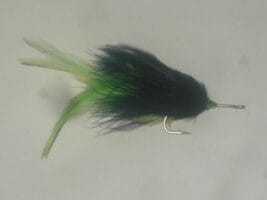Your cart is currently empty!
Cuba 4
This traditional pattern has proven itself on the pristine flats of Cuba’s rich fishing grounds, where bonefish remain relatively unpressured and traditional patterns still reign supreme.
Description
The Cuba 4 represents a classic Cuban bonefish pattern that embodies the minimalist yet highly effective approach to flats fishing that has evolved in Cuban waters. This traditional pattern has proven itself on the pristine flats of Cuba’s rich fishing grounds, where bonefish remain relatively unpressured and traditional patterns still reign supreme.
Design Philosophy and Heritage
The pattern reflects the deep understanding of Cuban guides and anglers who have fished these waters for generations:
- Minimalist design
- Natural presentation
- Traditional materials
- Proven effectiveness
- Local knowledge integration
Materials and Construction
Traditional Components:
- Hook: Size 4 saltwater hook
- Thread: Tan or natural
- Body: Light tan dubbing
- Wing: Light cream bucktail
- Flash: Minimal pearl Krystal Flash
- Eyes: Small bead chain
Key Design Elements:
- Slim profile
- Natural colors
- Limited flash
- Subtle movement
- Quick-sinking characteristics
Technical Specifications
Hook Configuration:
- Style: Saltwater
- Size: 4
- Strength: Strong
- Finish: Stainless steel
- Point: Chemically sharpened
Body Construction:
- Thread: Fine
- Body: Sparse
- Wing: Moderate
- Profile: Slender
- Action: Natural
Fishing Applications
Water Types:
- Cuban flats
- Shallow waters
- Sandy bottoms
- Turtle grass areas
- Various tidal conditions
Seasonal Effectiveness:
Spring:
- Early season
- Warming waters
- Tailing fish
- Variable depths
- Multiple presentations
Summer:
- Peak season
- Morning/evening fishing
- Bright conditions
- Technical fishing
- Shallow water
Fall:
- Late season
- Changing conditions
- Aggressive takes
- Multiple depths
- Various speeds
Advanced Fishing Methods
Presentation Techniques:
- Traditional Strip
- Slow retrieve
- Natural movement
- Depth control
- Line management
- Angle considerations
- Situational Adaptations:
- Quick strips
- Dead drift
- Varied retrieves
- Bottom bouncing
- Multiple depths
Water Reading and Strategy
Key Factors:
- Tidal movement
- Water clarity
- Bottom composition
- Temperature
- Light conditions
Strategic Approaches:
- Leading the fish
- Proper placement
- Distance control
- Presentation angles
- Pattern selection
Environmental Adaptations
Light Conditions:
- Bright sun
- Cloudy days
- Early morning
- Evening light
- Variable visibility
Water Clarity:
- Crystal clear
- Slightly cloudy
- Wind-affected
- Tidal influence
- Various conditions
Pattern Benefits
Design Advantages:
- Proven effectiveness
- Natural appearance
- Quick sinking
- Easy casting
- Durable construction
Performance Benefits:
- Consistent results
- Natural movement
- Bonefish attraction
- Energy efficiency
- Versatile application
Advanced Applications
Specialized Techniques:
- Sight fishing
- Blind casting
- Tailing fish
- Cruising fish
- Mudding fish
Tactical Adaptations:
- Wind conditions
- Water depth
- Fish behavior
- Tidal stages
- Light angles
Historical Significance
Pattern Origins:
- Traditional design
- Local development
- Proven history
- Guide-tested
- Time-honored
Cultural Impact:
- Cuban fishing heritage
- Pattern evolution
- Modern influence
- Global recognition
- Contemporary use Advanced Flats Techniques Tidal Stage Applications:
- Incoming tide approaches
- Peak high tide presentations
- Outgoing tide strategies
- Low tide adaptations
- Transitional periods
Each tidal stage requires specific adjustments:
- Incoming: Lead fish further, anticipate faster movements
- High: Focus on mangrove edges and deeper pockets
- Outgoing: Target channels and depressions
- Low: Concentrate on remaining deeper areas
- Transitions: Be ready to modify retrieve speeds
Specialized Situations
Mudding Scenarios:
- Identifying mudding activity
- Proper approach angles
- Presentation distances
- Retrieve variations
- Pattern modifications
School Fishing:
- School identification
- Leading the group
- Multiple cast strategies
- Pattern spacing
- Energy conservation
Weather Adaptations
Cloudy Conditions:
- Pattern visibility enhancement
- Modified retrieve speeds
- Depth adjustments
- Flash considerations
- Alternative presentations
Wind Management:
- Crosswind casting
- Downwind presentations
- Upwind challenges
- Line control techniques
- Leader adjustments
Advanced Pattern Rigging
Leader Configurations:
- Standard clear situations
- Cloudy water adaptations
- Wind-affected setups
- Depth requirements
- Tippet selections Cuban Flats Specifics Regional Adaptations:
- Cayo Largo presentations
- Jardines del Rey techniques
- Cayo Cruz approaches
- Las Salinas strategies
- Isla de la Juventud tactics
Each region requires specific considerations:
- Cayo Largo: Deeper presentations on coral-based flats
- Jardines: Shallow water sight-fishing adaptations
- Cayo Cruz: Working around mangrove channels
- Las Salinas: Dealing with varied bottom structure
- Isla de la Juventud: Handling stronger tidal influences
Advanced Presentation Methods
Distance Control:
- Close-range accuracy
- Medium-distance precision
- Long-range techniques
- Wind compensation
- Pattern turnover
Speed Variations:
- Ultra-slow retrieves
- Standard strips
- Quick bursts
- Stop-and-go
- Combination methods
The Cuba 4 represents the perfect fusion of traditional design and proven effectiveness. Its sophisticated engineering incorporates generations of local knowledge with practical simplicity, creating a pattern that consistently produces results with Cuban bonefish. Whether targeting fish on pristine flats or challenging shallow waters, this pattern delivers exceptional performance through its carefully calculated design elements and versatile presentation capabilities.
Additional information
| Hook type | Barbed Hooks, Barbless Hooks |
|---|---|
| Hook size | 10, 12, 14, 16, 18, 20, 6, 8 |







